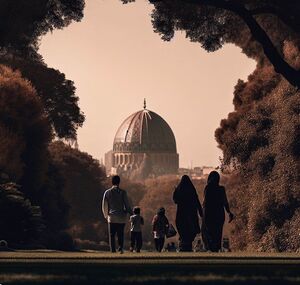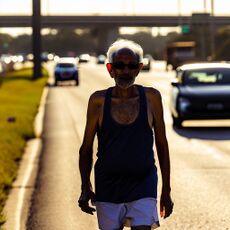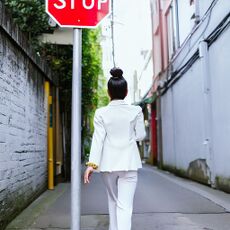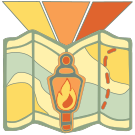Walking: Difference between revisions
No edit summary |
No edit summary |
||
| Line 4: | Line 4: | ||
|Content= | |Content= | ||
{{Under construction|Additional content and cleanup needed.}} | {{Under construction|Additional content and cleanup needed.}} | ||
== Headlessness - ''Intermediate'' == | == Headlessness - ''Intermediate'' == | ||
| Line 18: | Line 13: | ||
|Landmark1=Simple Mindfulness While Walking | |Landmark1=Simple Mindfulness While Walking | ||
|Landmark2=Perceiving Parts as a Whole | |Landmark2=Perceiving Parts as a Whole | ||
|Landmark3=Explore Presence While Walking | |||
}} | }} | ||
Revision as of 14:44, 23 September 2023
 | |
| Guide: Walking | |
|---|---|
| Landmarks | Simple Mindfulness While Walking Perceiving Parts as a Whole Explore Presence While Walking Try Headlessness While Walking |
Guides are a Pathway in The Map of Everyday Enlightenment which are typically articles about a particular time and place for meditative practices. Guides contain Landmarks that highlight examples of how this could work for you, as well as other explanations of how to make use of certain concepts or techniques. The Landmarks in Guides can be reviewed in the context of progress through the Realms of Everyday Enlightenment, and when used in that way, Guides become another way to decide where to go next.
The Guide to Walking suggests that Walking is kind of unique, in that it offers a variety of opportunities to exercise your awareness and perception.
| This page is under construction Additional content and cleanup needed. |
Headlessness - Intermediate
Walking is a perfect time to perform Headless Exercises. Try the following types of things.
- Become headless (if you don't know about this, follow the links)
- Become aware of your surroundings in an open, spacious way, noticing how that space includes the location where your head should be
- Expand your headless awareness to your whole body, letting go of the sense of self, ultimately feeling the flow of your walking as a property of The Now, rather than something You are doing or experiencing.
Use the following Landmarks as ways to integrate meditative practices into your everyday life and to check in on how you are progressing in your own journey.
Landmark: Simple Mindfulness While Walking
 | |
| Landmark: Simple Mindfulness While Walking | |
|---|---|
| Beacons | Attention |
| Realms | Enrollment |
| Lenses | Mindfulness |
| Guides | Walking |
The Landmark of Simple Mindfulness While Walking is a good place to start practicing Mindfulness throughout your day. You should be able to be mindful anytime at all, and working on micro-meditative practices can be done in many different ways and places. This Landmark is within the Realm of Enrollment, and is part of the Beacon of Attention, more specifically the Lens of Mindfulness.
Landmark Lookouts:
- Simple Mindfulness: Can you shift into a calm, attentive state where you are paying attention to what is around you?
- Mindful Walking: Can you experience a Mindful state, or Mindful qualities while walking or going about your day?
Wherever will be walking next should be a great time to be Mindful. Practice these types of steps.
- Try to just simply be as mindful as you know how, and be attentive to the walk, bringing your attention back to whatever feels pleasant, rather than allowing thoughts to distract you.
- Be aware of the sky and consider it as a ceiling or dome enclosing you in an area. Feel the quality of this area and how you are walking through it. Rest in this area and sense that it is the only place that exists in The Now.
- Whenever you notice your mind wandering, don't worry about that, and simply enjoy any mindful strategy for your current walk
- Your feet are walking - notice the sound of your feet, the feeling of the steps
- Your face - wind and sun create sensations on your face
- Noises - what are the most pleasant and calming noises?
- The Now - remember that you are "here" and it is the perfect place to be right now.
Landmark: Perceiving Parts as a Whole
 | |
| Landmark: Perceiving Parts as a Whole | |
|---|---|
| Beacons | Adaptation |
| Realms | Engagement |
| Lenses | Special Composition |
| Guides | Walking |
The Landmark of Perceiving Parts as a Whole is a chance to perceive how a lot of things we see everyday can be grouped together naturally to form nearly arbitrary "wholes". This Landmark is within the Realm of Engagement, and is part of the Beacon of Adaptation, more specifically the Lens of Special Composition.
Landmark Lookouts:
- Notice the Parts: Can you see things that are similar in some ways and could be grouped together (such as cars and trees)?
- Think About the Parts: Can you see all the ways that these types of "parts" (cars, trees) are both similar (in appearance, purpose, motion, etc.) and yet still individual?
- Think About the Whole: Can you shift your perception to see a new type of whole - individuals (cars, trees) with their own purpose, but all part of an interconnected system?
There are many exercises you can do while Walking, including the following Special Composition concepts. Depending on where you walk, try out some of these ideas.
- Trees - individuals, clusters, trees of the same species, etc. - How are they individuals, and how are they parts of a whole?
- Sidewalks and the grass next to them, parallel to the road, parallel to the sidewalk across the street - Even though the sidewalks are not "one thing", they are clearly two halves with the same intention - to allow people to walk along the road.
- Streetlights - alongside the sidewalks, in the grass, lighting the street - These are connected through an electric cable, they would typically light up at the same time, and yet they are individual lights that don't seem to be part of a whole. Look now at all the streetlights you can see, and notice how they are in fact one thing - the night-lighting for that area.
- Telephone poles - similar to the streetlights, but not the same at all - Clearly a street light isn't connected to a telephone pole. But do all the telephone poles and all the streetlights fit together into one system? What is that system? Does it include the sidewalks and streets, and why?
- Cars - think about the different ways cars are related. One car - just going somewhere. Two cars - staying safely away from each other and matching the same speed. All the cars - working together to move forward in a way where everyone can get where they want to go. Opposite lanes (going in different directions) - are these separate things just because they're going in different directions, or are they still all part of one system of getting people and things where they need to go?
- People walking in the same direction, and in the opposite direction - all the same ideas as with cars, but now it's much easier to see the intention and individuality. Is there a "whole" when thinking about all the people you see? What about "all the people who chose to walk here today" - is that a "whole"?
Landmark: Explore Presence While Walking
 | |
| Landmark: Explore Presence While Walking | |
|---|---|
| Beacons | Attention |
| Realms | Engagement |
| Lenses | Presence |
| Guides | Walking |
The Landmark of Explore Presence While Walking shows some perceptions shifts that provide deeper understanding of how to Experience the Now, especially relating to how the present moment is the only moment that ever exists in consciousness. This Landmark is within the Realm of Engagement, and is part of the Beacon of Attention, more specifically the Lens of Presence.
Landmark Lookouts:
- Typical Perception of the Present: Can you observe how we typically experience The Now as a few minutes of time (rather than as an instant) - connected to what happened just before, and what will probably happen next?
- Explore Perception of the Present: Are you able to regularly experience the Present as independent from the past and future - as if it was the only snapshot of your life that exists?
While walking, whether in a park, on the way to the subway, around your house, or at work, you can experiment with your perception of The Now.
- Typical Walking - As you move around, notice how easy it is to think of this moment as a journey that connects us to where we've just been, and where we're going next. Things around us are in motion, and are changing the whole time, and we are navigating through our world.
- Conveyor belt - Shift your perception to the sense that you are standing still, and the world is moving. Perhaps the world is a treadmill, and you are merely "keeping up" with its motion. Or perhaps you are standing still and the world is morphing or warping in a way that brings things closer to you or farther from you.
- Timeless walking - Notice a fixed marker such as a light pole, and as you walk towards it, shift your perception to the sense that you are in fact not walking at all, because without any "time" beyond the now, you will simply always be as close to that marker as you are, and there is no change in that distance, because each moment exists independently, and each "new now" simply exists with its own facts about reality.
- Timeless Stairs - do the same exercise when on stairs, as it is even easier. Whenever you take a step, pause for just a split second with one foot on the new step and one foot on the previous step. Notice that you have arrived at this location, and this is the present moment. After each step note that you are in the present moment. There is no journey, just present moments. Once you've learned to see this, learn to see it without any mental or actual pauses in your steps.
